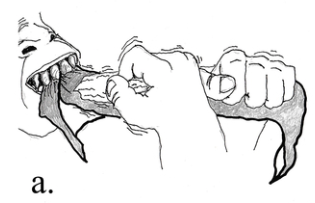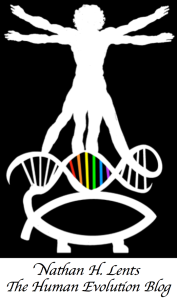In the human population, around 90% of us are right-hand dominant. That is, we find most tasks involving fine motor skills to be easier when done with the extremities on our right side. This preference is due to differences in the brain, not the arms, hands, or feet, and someone that is right-hand dominant is also right-foot dominant.

The early preference for fine motor work by one side of the body over the other quickly becomes self-reinforcing during childhood as we learn to write, use utensils, and even wear wristwatches according to our handedness. As adults, we find it awkward to write or catch with our non-dominant hand. Even such crude movements as those we make when feeding ourselves can be clumsy to do with the “other hand.” A southpaw friend and I recently played a game of darts in which we could only use our non-dominant hand, I my left hand and he his right. It took forever. I missed the board entirely a couple times.
This kind of handedness is only found in humans. Other apes and primates, which are notable among mammals for their extensive use of forelimbs for fine-motor tasks, display only subtle handedness. An individual primate may prefer one hand over the over for certain tasks, an effect that appears random and gets reinforced through repetition and practice. The breakdown of this mild left- vs. right-handedness is about 50% in primates other than us.

So why is right-handedness so much more dominant than left-handedness in humans? The answer is brain asymmetry. Humans are also unique among primates for our huge brains, but another aspect of our brains also sets us apart – asymmetry between the left and right hemispheres of the cerebral cortex. The cortex is the largest and outermost part of the human brain and cortical regions are where advanced cognition takes place. In fact, if we ignore the cerebral cortex, human and chimp brains are indistinguishable to all but highly trained specialists.
The human cortex is not just bigger, but it has whole new regions, such as the Broca’s and Wernicke’s area, responsible for delivering and understanding language, respectively. The human brain also developed specializations between the two sides, called hemisphere asymmetry or brain lateralization. By comparison, the brains of chimpanzees and other apes are almost perfectly symmetrical among the two hemispheres. The right side is a pure mirror image of the left and they work together to perform cognitive functions.
Not so with humans. In right-handed people, the left side of the brain is larger and well-developed; in left-handed people, the right side is larger. This is because the motor and sensory perception regions of our brains are cross-wired so that the left hemisphere conducts inputs and outputs to the right side of our bodies and vice versa.

Furthermore, certain cognitive skills seem to be housed mostly in one side of the brain or the other. For example, the brain centers responsible for facial recognition are almost always housed in the right hemisphere in right-handed people and in the left hemisphere for left-handed people. However, while the aforementioned Broca’s area is housed completely on the left side in 95% of right-handers, it is on the right side in only 60% of left-handers. In 20% of left-handers, Broca’s area is on the left side, and another 20% use both sides for Broca’s functions, like most ambidextrous people do.
Clearly, handedness and brain lateralization are related, but it’s a complicated picture and almost nothing is known about how it develops.
Paleontologists studying the evolution of the human brain from our ape ancestors have always had a tough challenge. Soft tissue doesn’t fossilize. For most extinct hominid species, the best we can do is estimate the total brain size. Early in the history of paleoanthropology, scientists assumed that big brains were the first anatomical innovation in the human lineage and then upright walking, reduction of the face, shrinking of the canine teeth, and other adaptations came later. We now know that this is not true. By three million years ago, multiple hominid species were walking fully upright but still had tiny chimp-sized brains.
There is one tool that paleontologists have used to determine something about brain shape using only a recovered skull: endocasts. After pouring hot rubber into a skull and letting it harden, scientists can detect and measure impressions on the inner surface of the skull left by the grooves and folds of the brain that was once housed therein. The resulting mold is like a low-resolution 3-D print of the outer surface of the brain of a long-dead hominid.

Using the endocast technique, scientists have learned many interesting things about the evolution of brain structures in the human lineage. The currently held theory is that the spatial reorganization of the brain actually preceded its expansion. While our ancestors were still operating with small brains, but with upright posture, their brains were undergoing changes in the way the brain was organized and how information was processed. This “set the stage” for the rapid expansion of the brain that would follow. So far, there is some evidence that lateralization, the specialization of tasks on different sides of the brain, was part of that reorganization that begin in our small-brained ancestors.
Big support for this notion was just discovered in a seemingly unlikely place: the stripes and grooves on the surface of teeth from Homo habilis. Nicknamed “handy man” for having been the first known hominin to be associated with tool use, H. habilis is often considered the first member of the genus Homo, and therefore, in the taxonomic sense, the first human. (Although H. naledi may soon be announced to be older.) H. habilis is a perfect embodiment of how current theory supposes that our ancestors began upright walking and a terrestrial, rather than arboreal, lifestyle while the brain remained small and mostly ape-like.

In a new study, scientists examined the teeth striations on a specific H. habilis specimen and found that the striations were likely made by a right-handed individual. To understand why, it is first important to understand how the striations were made. In many species of hominids, it is thought that individuals held pieces of meat stretched between their teeth and one hand, while cutting the meat with the other hand using a sharp hand axe. The two cartoons below capture it.


Cutting meat was an important behavior in our ancestors because they had lost the sharp canines that other apes have and therefore could not simply bite into a hunk of raw meat. As any chef can tell you, raw meat is tough and only a properly sharpened knife will do the trick. Until fire was cultivated, we had to cut our meat into manageable chunks before we could consume it. Cooking completely changes the texture of meat and there is no need to cut it before biting pieces off of a large slab of it (table manners aside).
The striations that we see in the teeth of many hominids include habilis, Neanderthal, H. erectus, and even archaic H. sapiens are the tell-tale signs of cutting meat, and this new study proposes that the direction of the striations tell us about the direction that the cutting was performed and thus the hand that was used. If there were no handedness, we would expect some striations going one way, and some going the other, but that’s not what we see. Instead, the striations all point toward the right, indicating that this 1.8 million year-old H. habilis was right-hand dominant.
This important finding paves the way for us to understand when dominant-handedness first began in our lineage. If other fossils of habilis, as well as those of erectus, naledi, and maybe even austrolopiths, display similar right-hand preference, that will support the tentative conclusion that brain lateralization long preceded brain expansion. Indeed, habilis is already thought to have exhibited lateralization due to discoveries with partial endocasts.
On the other hand (pardon the pun), if this habilis was an anomaly and others show a more random pattern of striations, we will have to look elsewhere for answers to this question.
-NHL

Noi siamo sepre stati uomini sin dalle nostre origini. Le scimmie e gli altri primati sono una specie diversa dall’uomo.Il genere umano è stato ingannato per i dollari. Grazie
LikeLike
So fascinating!
https://historyisfascinating.wordpress.com/
LikeLike
I was taught that the world is only 7000 years old, and that God was the Creator of heaven and earth. Evolution has many missing puzzle pieces that no one can seem to find (e.g: dark matter, how life came to be, mutations, etc.) All that it takes to believe in God is faith. I beg you to stay open-minded. Please.
Genesis 1:1
“In the beginning God created the heavens and the earth.”
LikeLike
Science is, by definition, open-minded since we are always examining all new evidence that we find. Of course there are gaps in her knowledge, but those gaps are always being filled and then new ones exposed as we continue to dig deeper and push further in our understanding of the natural world and the universe. I am sorry that someone taught you that the world is 7000 years old, but that is most definitely not the case.
LikeLike